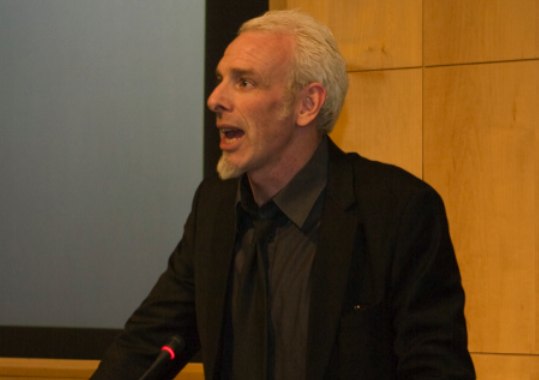Politics, Poetry and a Man Who Shaped Them
June 2009

Rodney Sharkey, Anglo-Irish literature expert and writing professor at
WCMC-Q, cut deeply and precisely into Yeats’ work.
Audience members expecting a straightforward lecture on William Butler Yeats’ life and work in the last of a series of literary lectures at WCMC-Q were in for a pleasant surprise. Rodney Sharkey, Anglo-Irish literature expert and writing professor at WCMC-Q, cut deeply and precisely into Yeats’ work, offering glimpses of his own boyhood in Dublin as a poignant way of exploring the genius behind the subject’s words and the formation of Irish culture in general. A crowd filled the lecture hall at WCMC-Q to hear his lecture entitled “Excited, Passionate, Fantastical Imagination: W. B. Yeats and the Personal Political.”
In humorous fashion, Sharkey admitted that as a teenager, he found Yeats’ work a turnoff, because all he seemed to talk about was death, and he didn’t look as cool as Samuel Beckett, or have the pirate likeness of James Joyce. But with the death of Bobby Sands—a political activist who perished on a hunger strike—the sobering reality of struggles in Ireland hit Sharkey along with his peers, teachers and family. And this shock would prove to open him up to Yeats’ way of thinking.
“The morning that Bobby Sands died, I went to school and it was like everything normal had been thrown out,” Sharkey said.
One day shortly after Sands died, Sharkey found himself studying for an exam and reading Yeats’ poem entitled “Easter 1916,” a piece about the Easter Rising in which protesters who sat in demonstration against English occupation were detained and executed.
“And suddenly, out of the blue, I heard this voice, I heard this voice in my head, I heard this anger, this frustration. I heard the articulation of the feeling I had had that morning I went to school—I heard William Butler Yeats,” Sharkey said.
Sharkey followed Yeats’ voice through an intense study of his writings and life and shared highlights of his findings in the lecture. One idea he returned to repeatedly was the notion that Yeats’ lived with and wrote about conflicting ideas in a way that fully acknowledged their coexistence.
“As I poured over ‘Easter 1916’ I noticed that there’s this sensational movement between death and birth, between execution and a life enshrined in the mythology of the country as a result of the poem. Even this opposition in the ith imagery provided by her collaborator, Watts’ stories grew much longer than expected and she was only able to share a portion of the story entitled “North.”
“Every morning the old man would wake from his nest of frost-stiffed blankets and revive the small driftwood fire inside his tent with handfuls of grass and dried curls of salty bark, stripped from the bent trees growing in the cliff’s narrow crevices,” Watts read from her work.
Moving into her last piece of the presentation, Watts described “Until The Lake Froze Solid,” a work that began with a phone conversation where Cooper discussed the ideas of “cracks in the normal, the disturbing under-layer, and the notion of rescue.” Watts used these notions to write a few pieces, which she sent back to Cooper. Through the exchange of preliminary drawings and narratives, a film produced by Cooper and her husband entitled “Until The Lake Froze Solid,” featuring Watts’ words and moving image and narration by Cooper, evolved.
“The ideas of enclosure, survival and hibernation, made me imagine an older woman living alone, wrestling with depression triggered by the death of a abusive husband, whose passing should have brought release. I wanted to explore the knots and contradictions of this complex relationship, continuing even past his death. I wanted to understand her complicated regret, sense of abandonment, self-blame and yet betrayal, and the looking away from unbearable secrets,” Watts explained of the writing process. “The ice here is thin, it overlays an immensity of cold, dark water, and there are cracks.”
The film ensued and the audience was again captivated by an escape into a secret world filled with—as is seemingly a trademark of Watts’ collaborative work—stunningly real sentiments.
Report by Emily Alp
